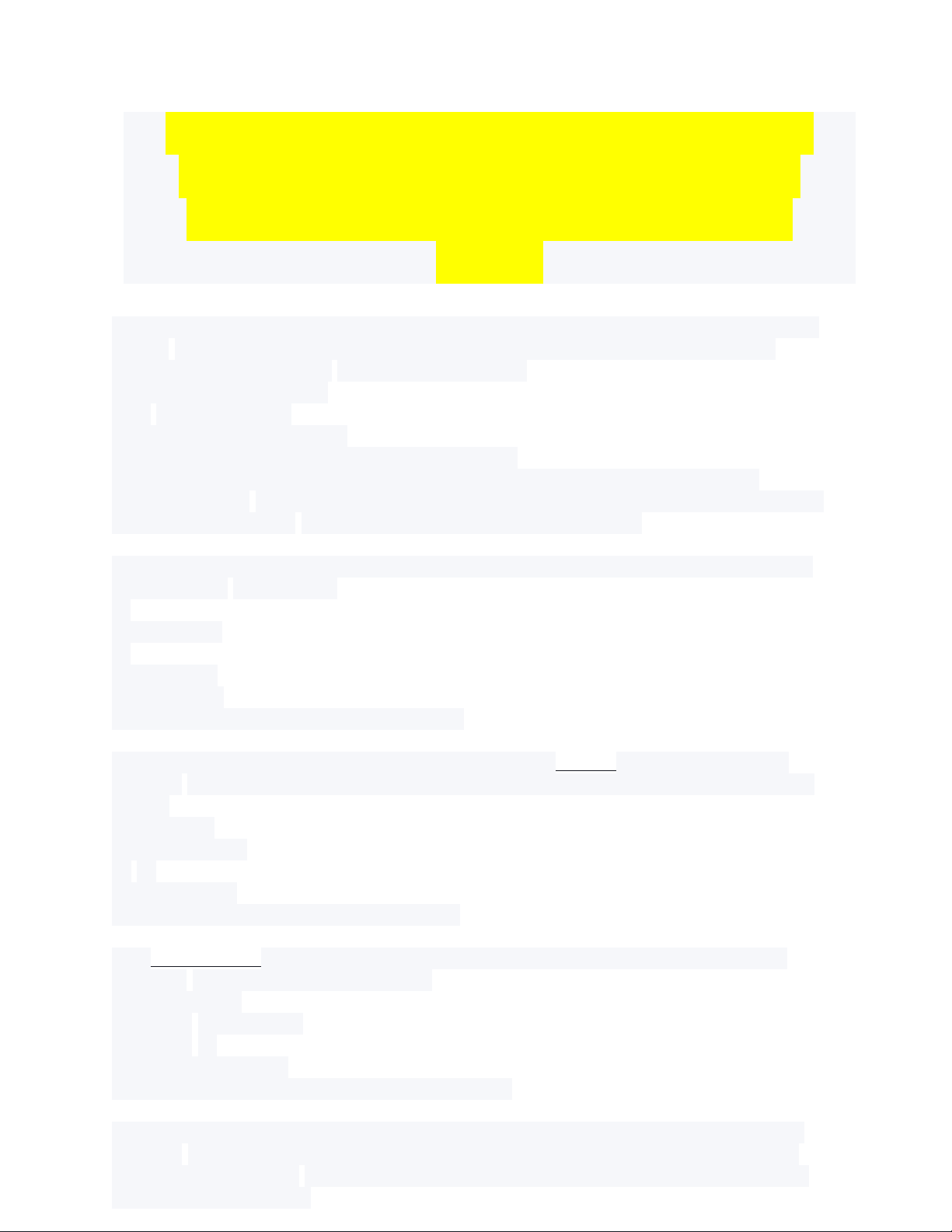
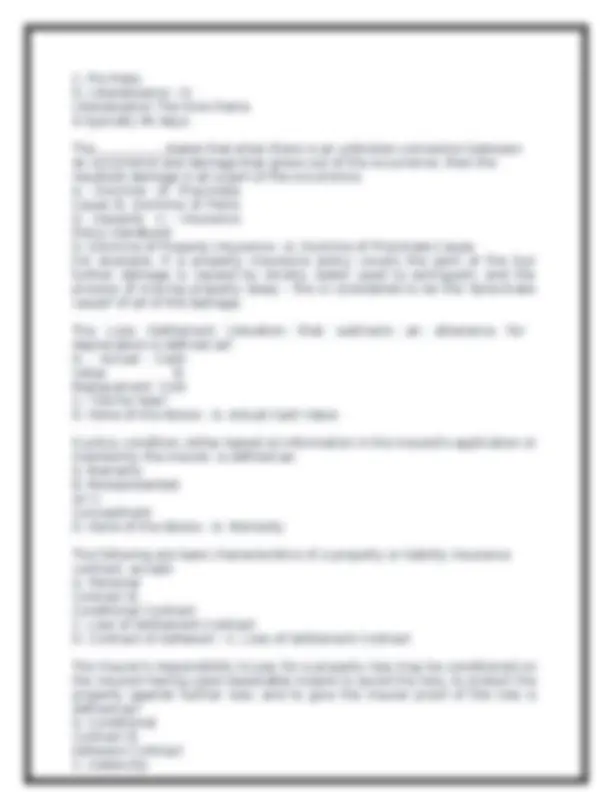
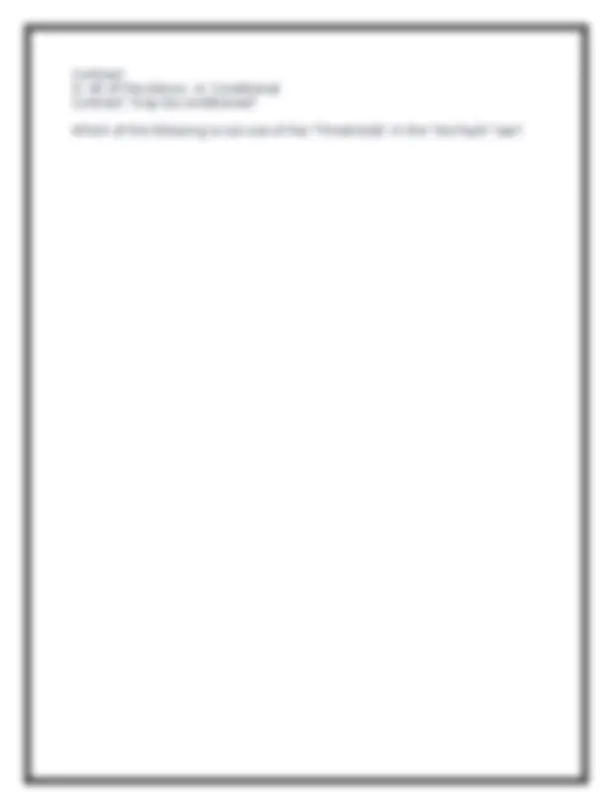
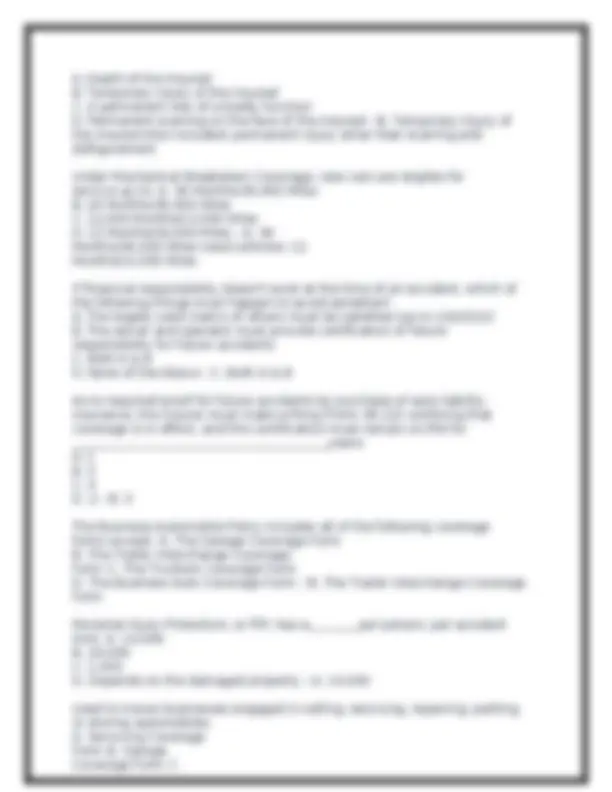
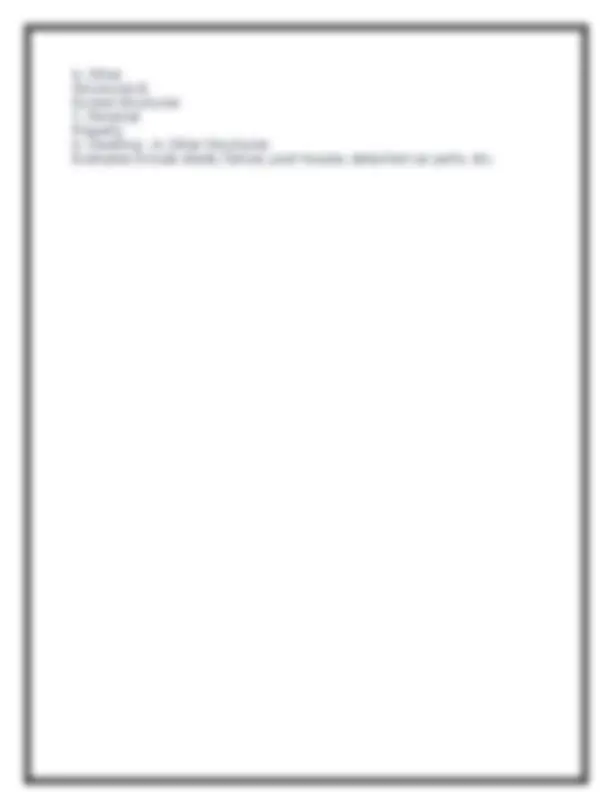
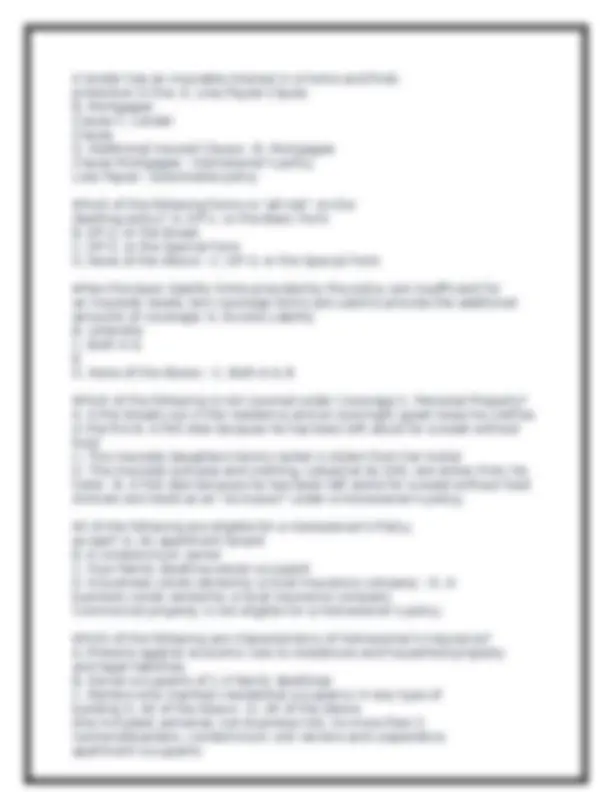
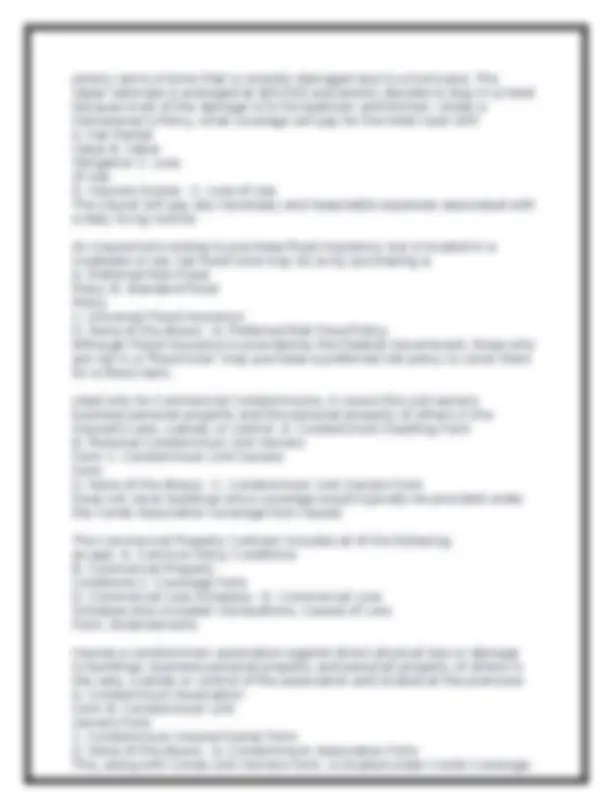
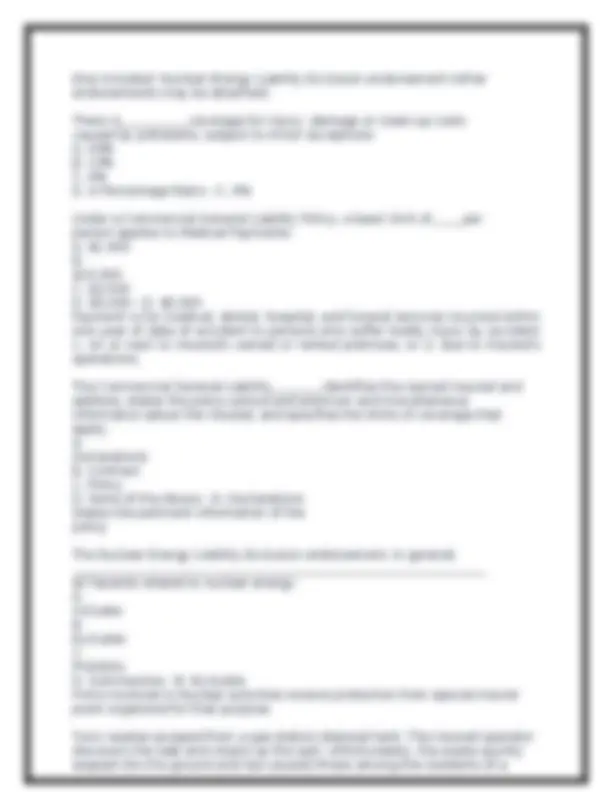
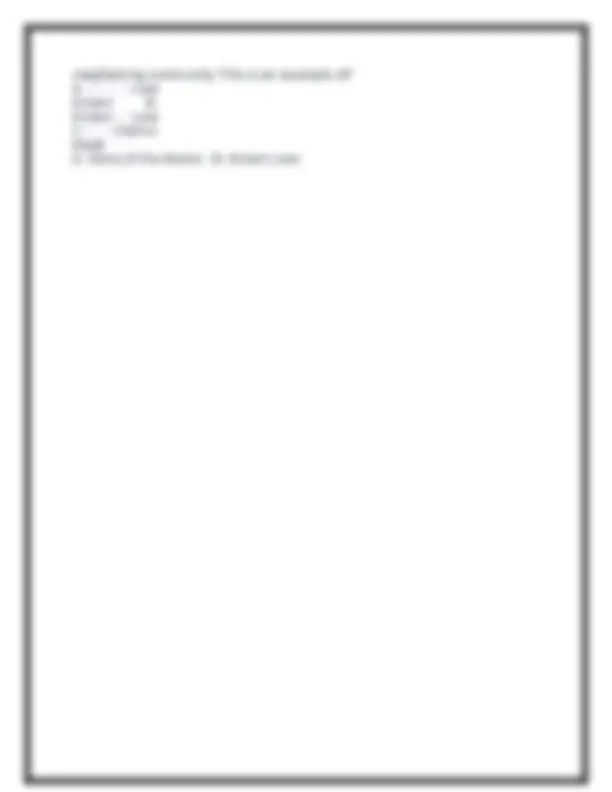
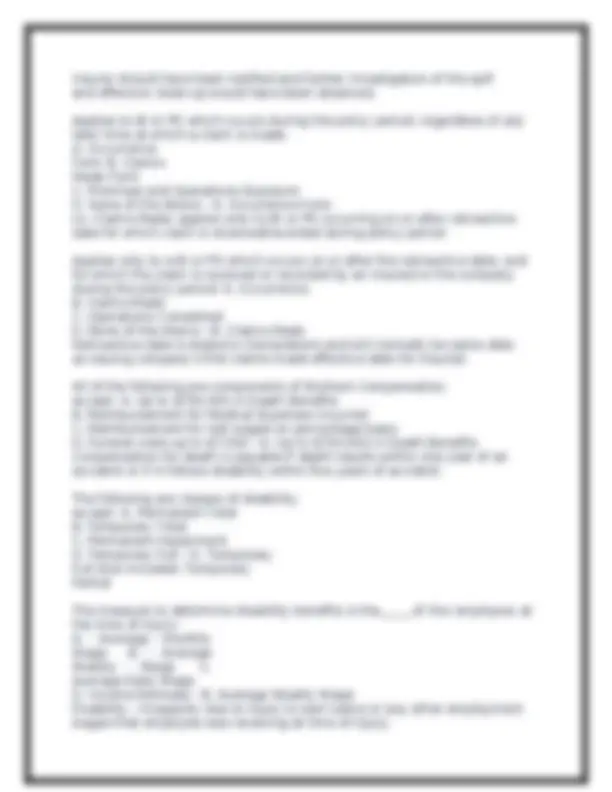
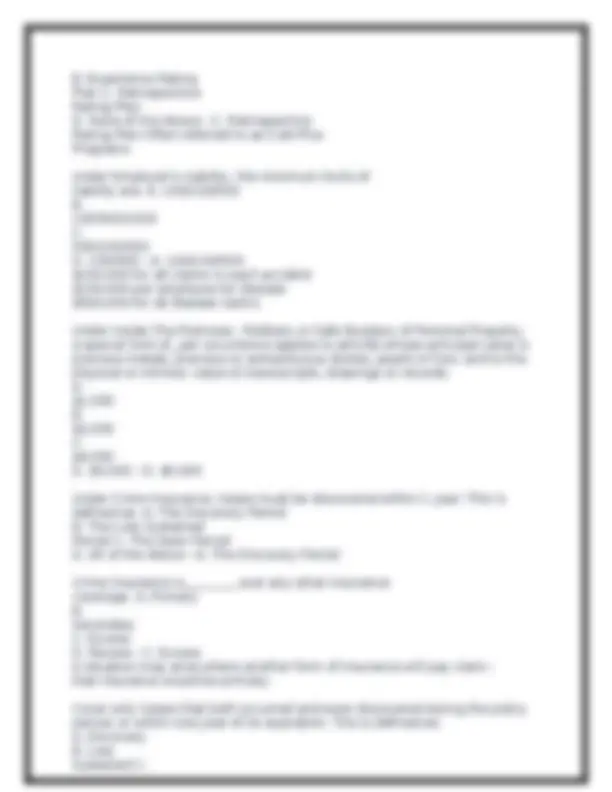
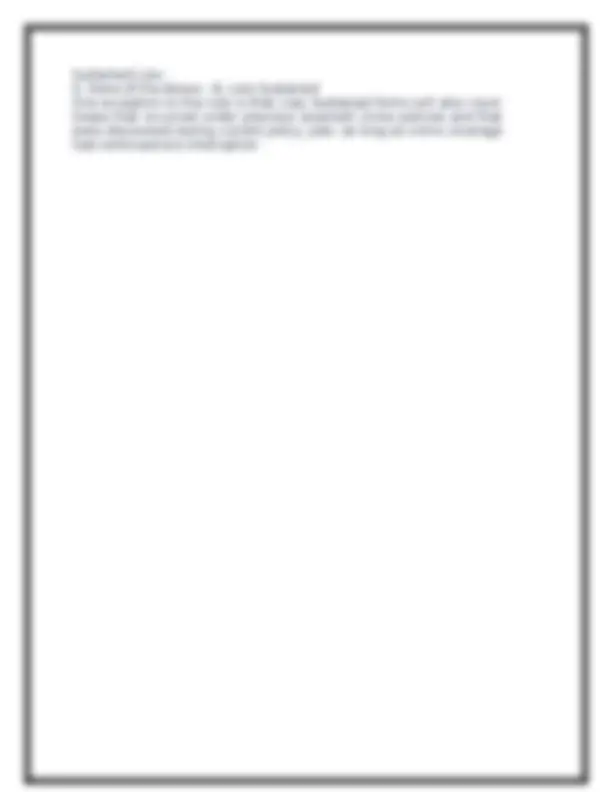
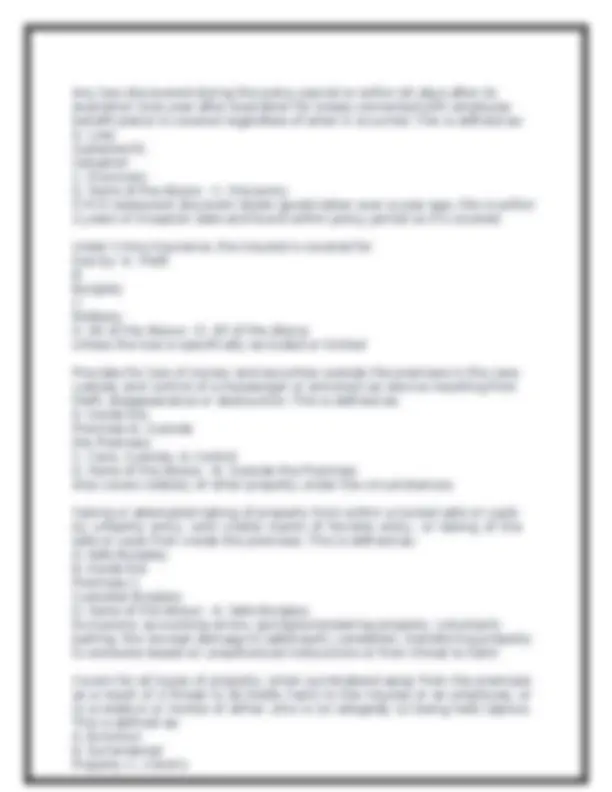
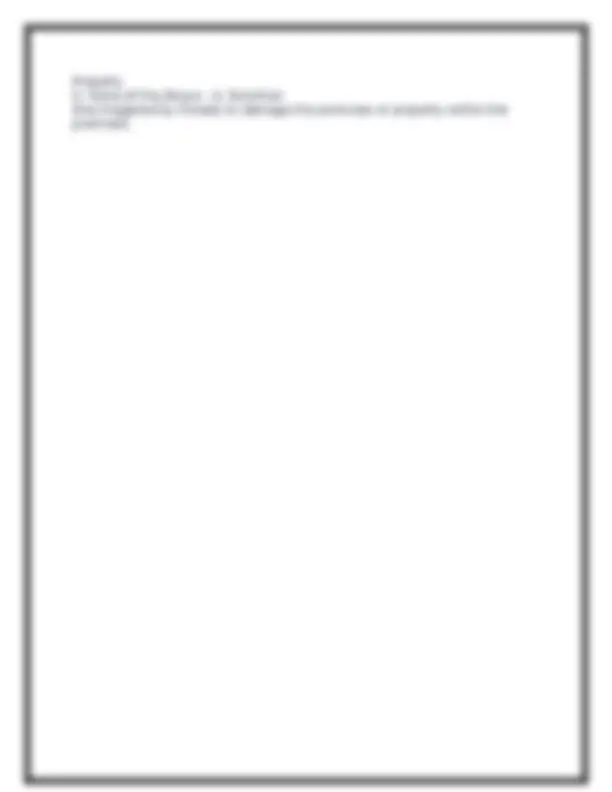
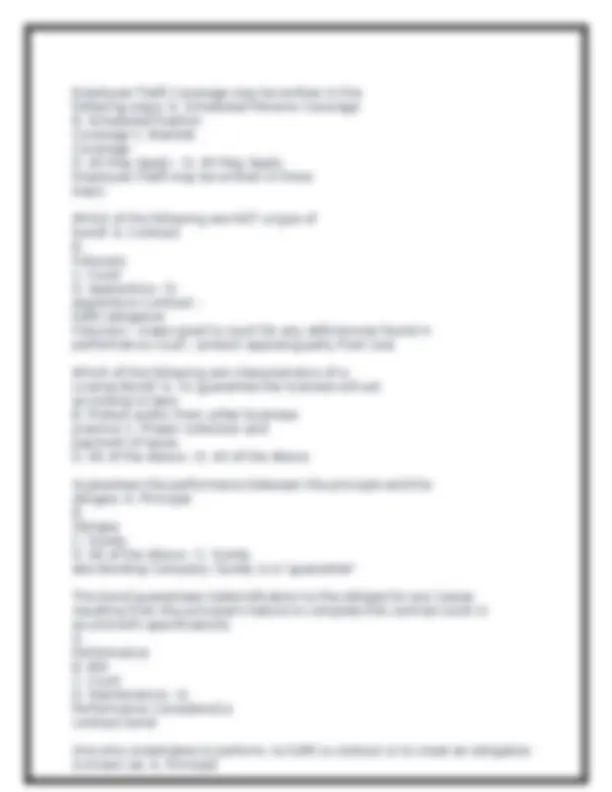
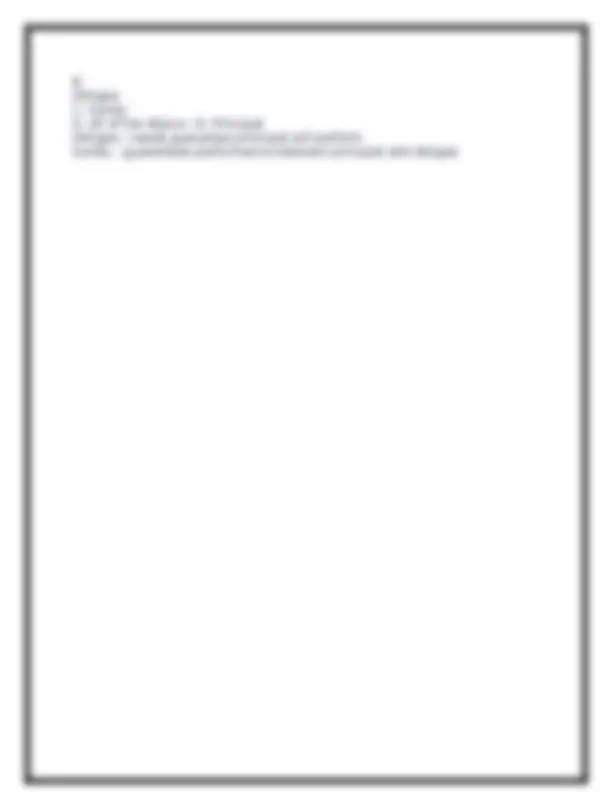
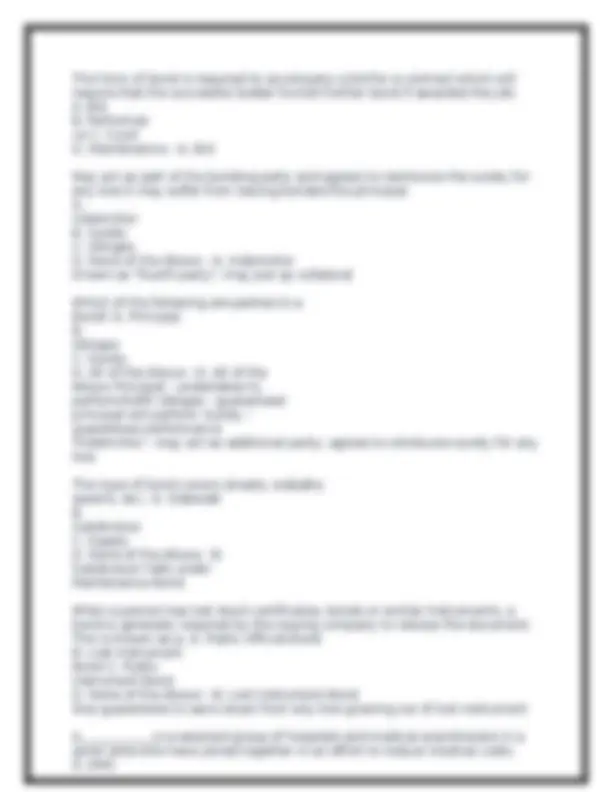
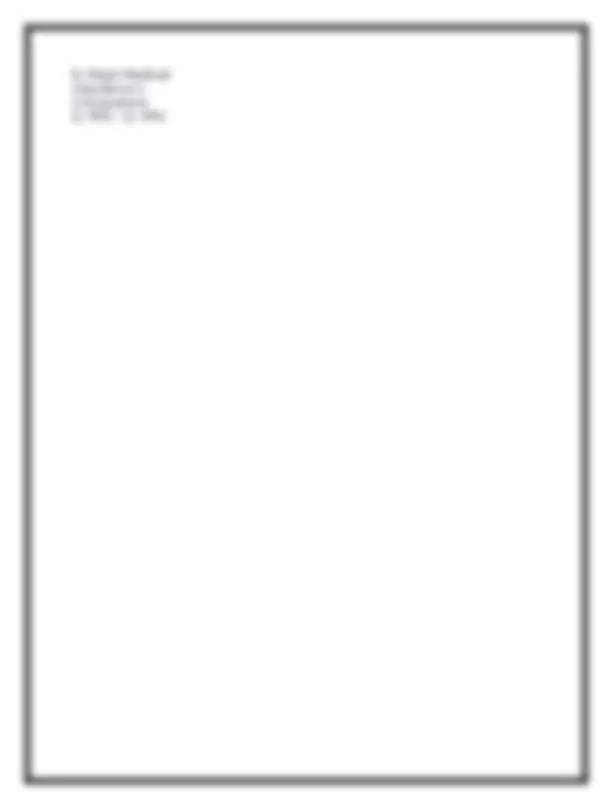
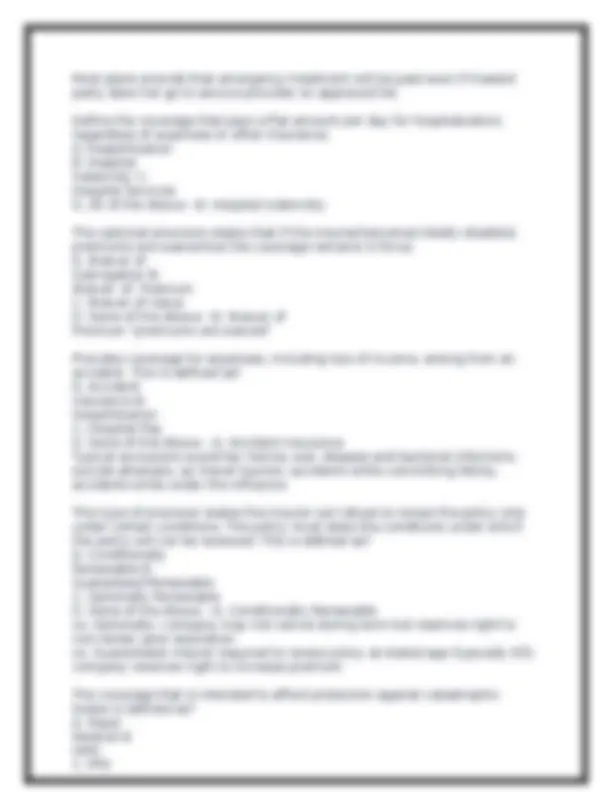
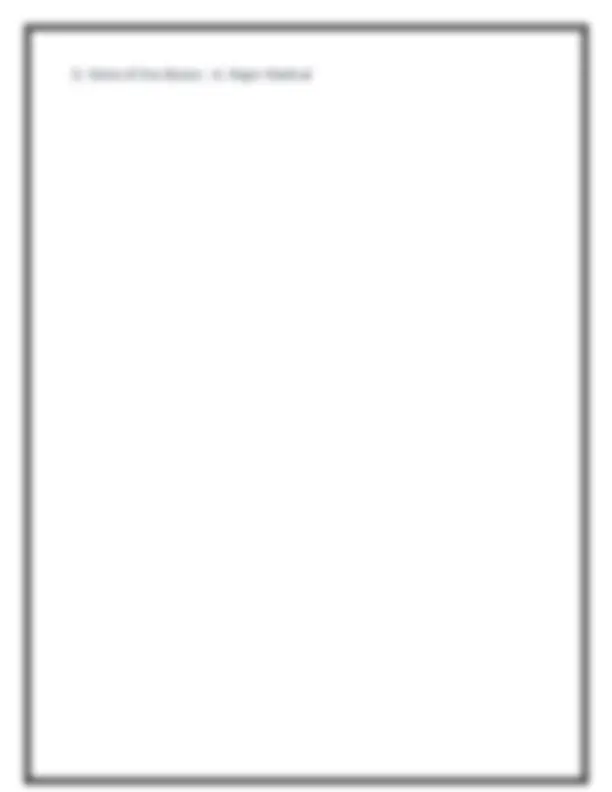
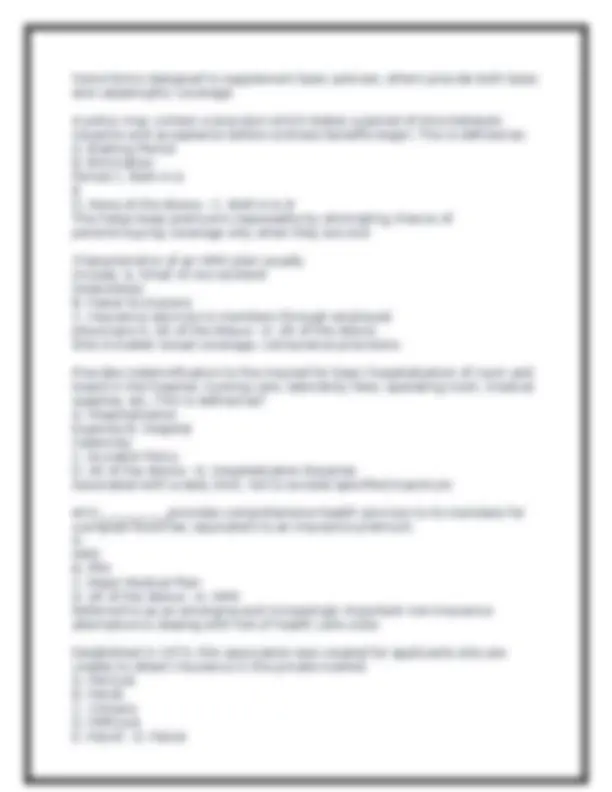
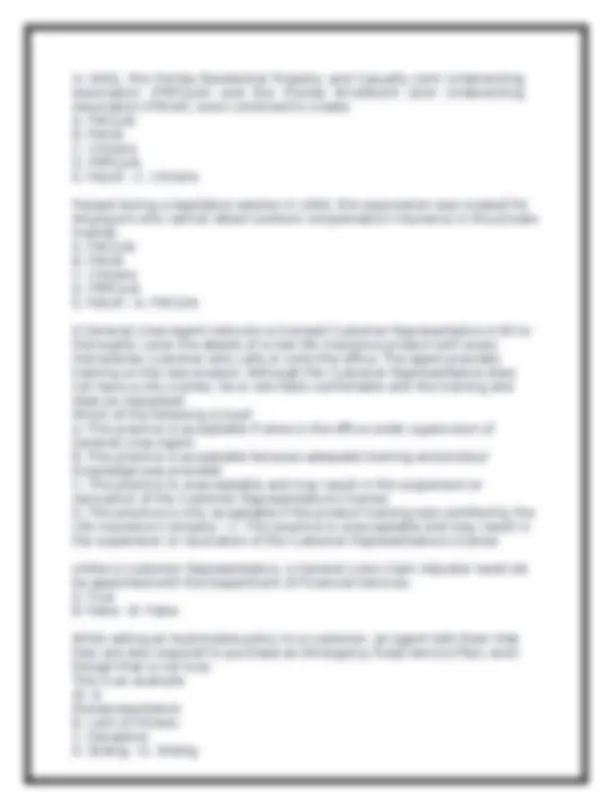
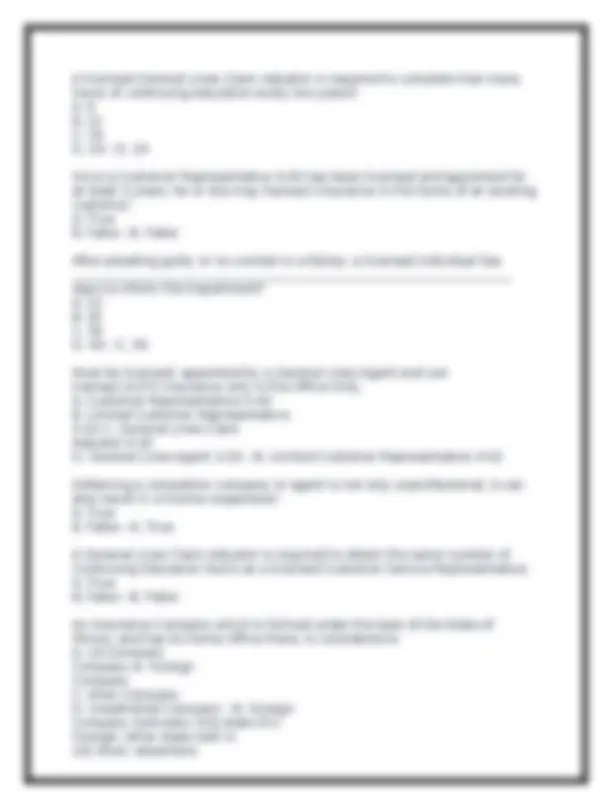
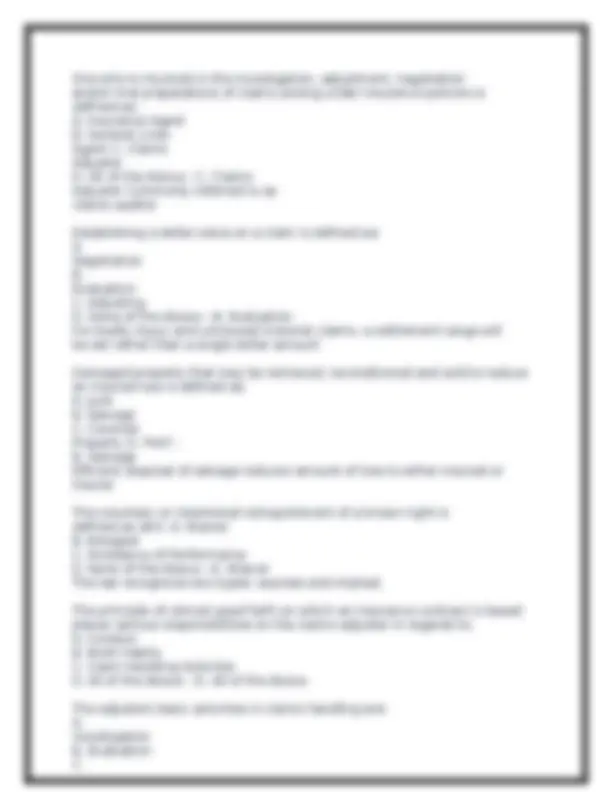
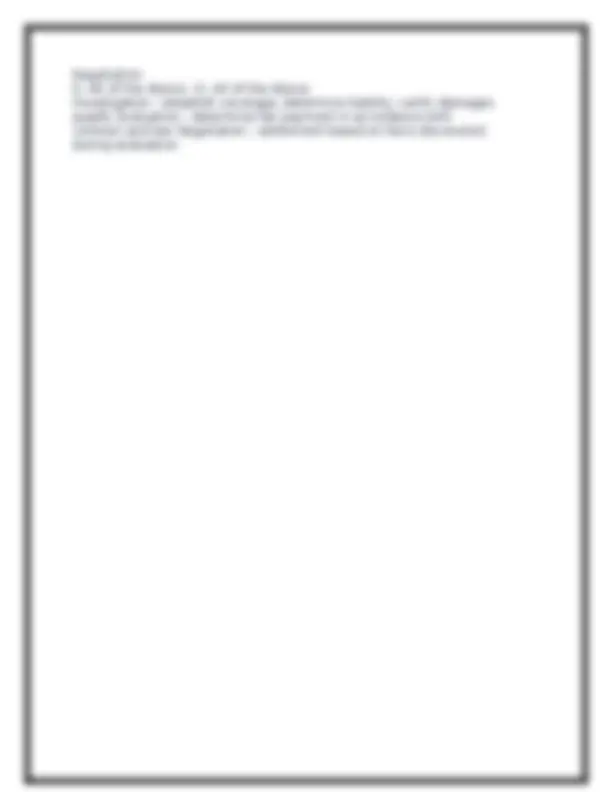
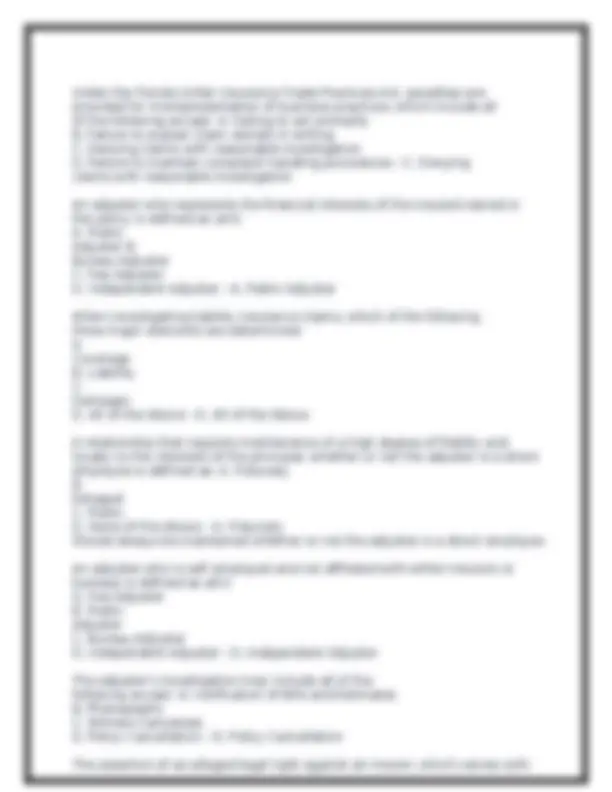
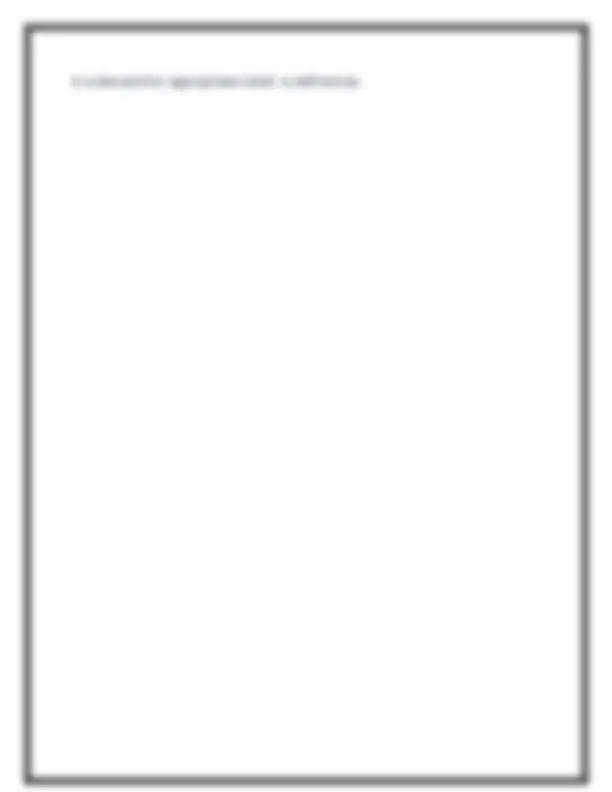
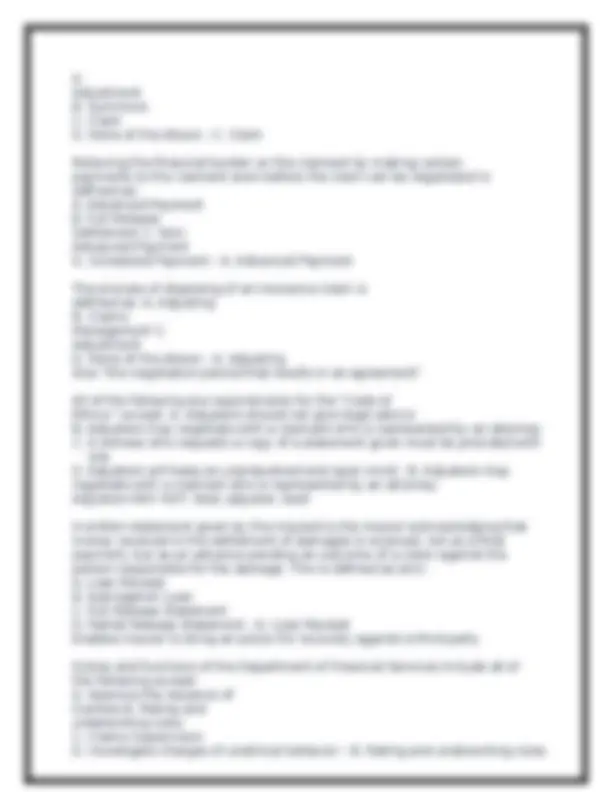
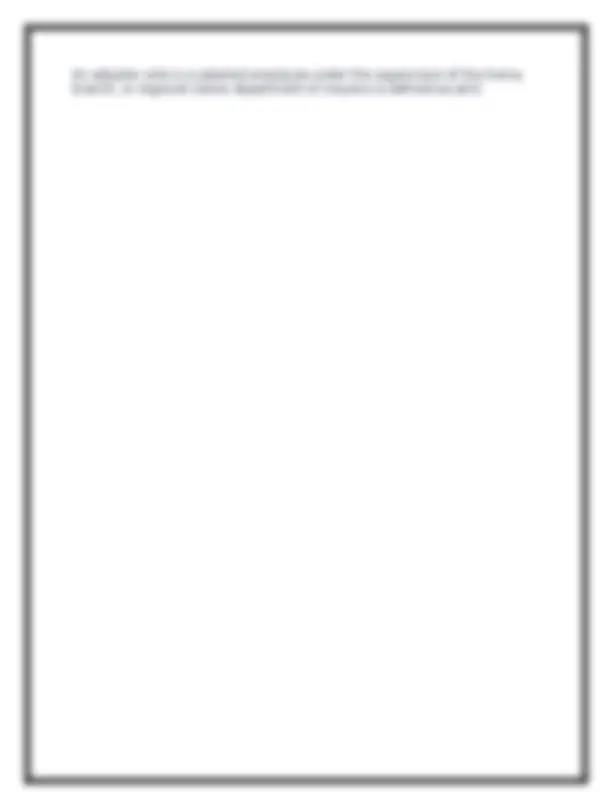
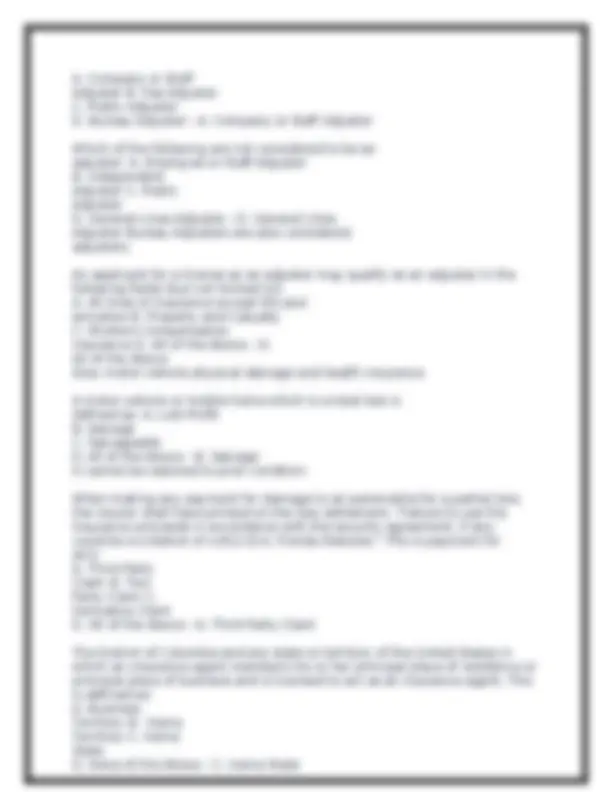
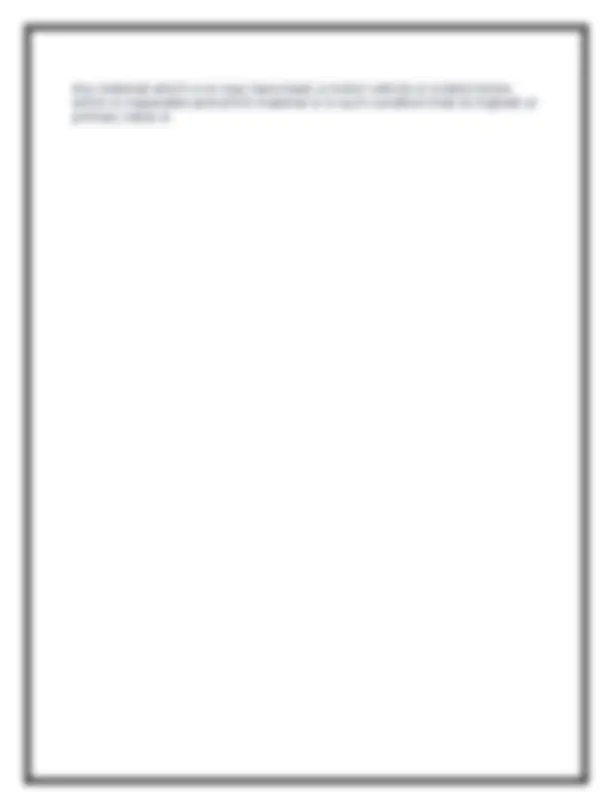
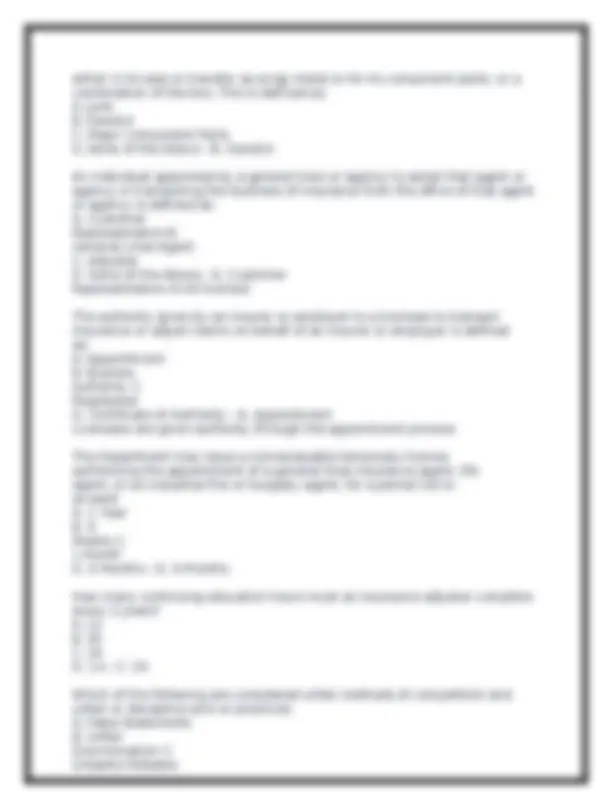
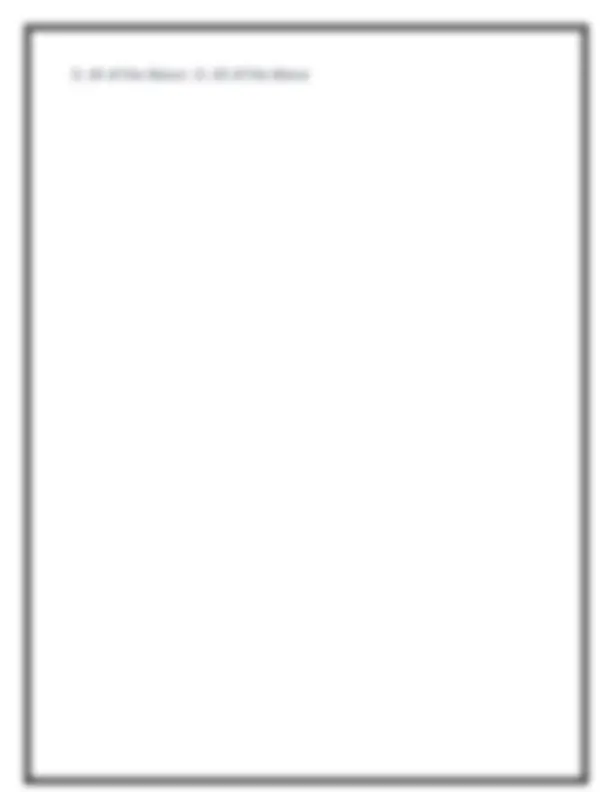
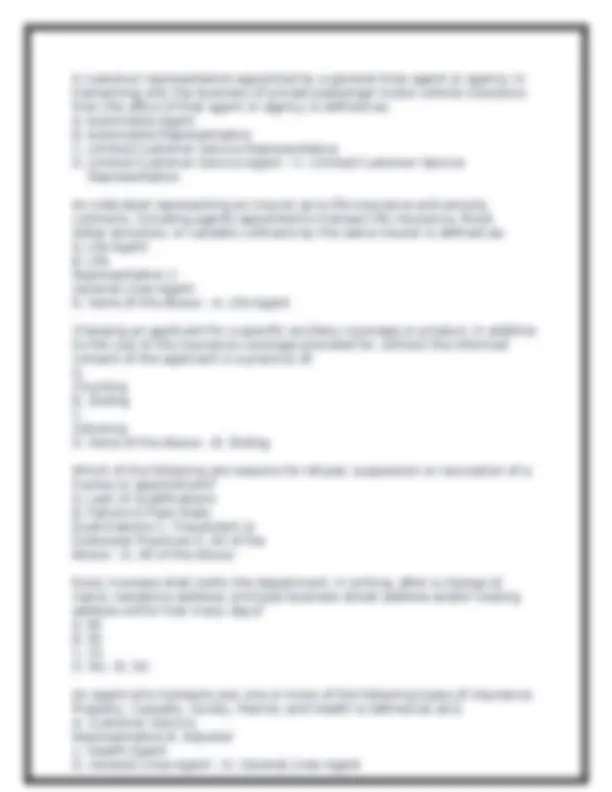
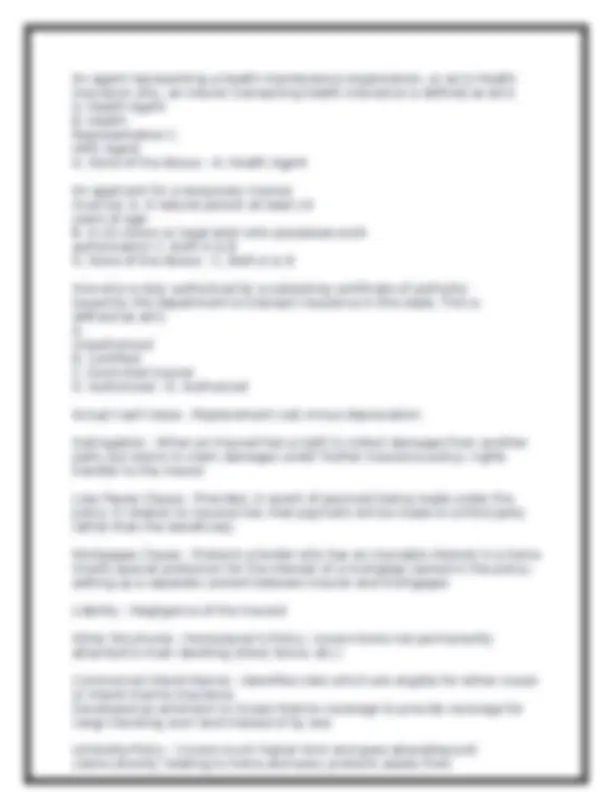
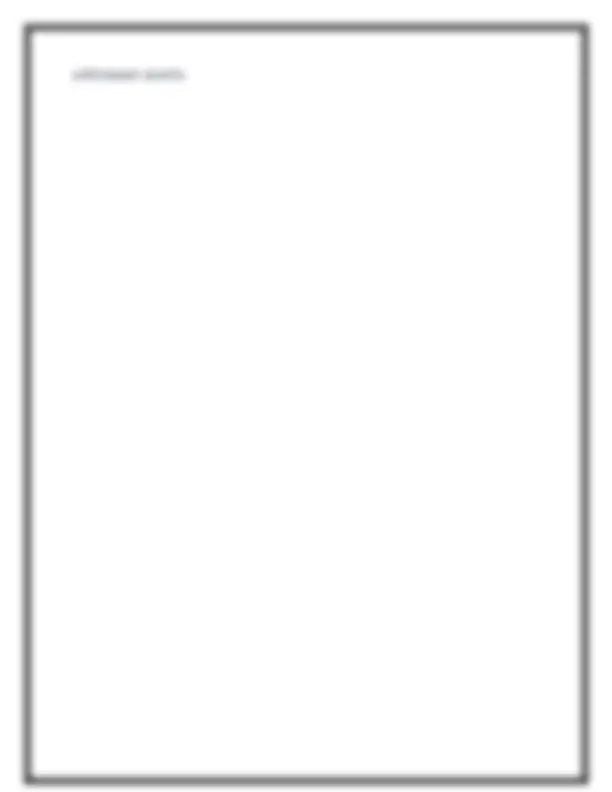
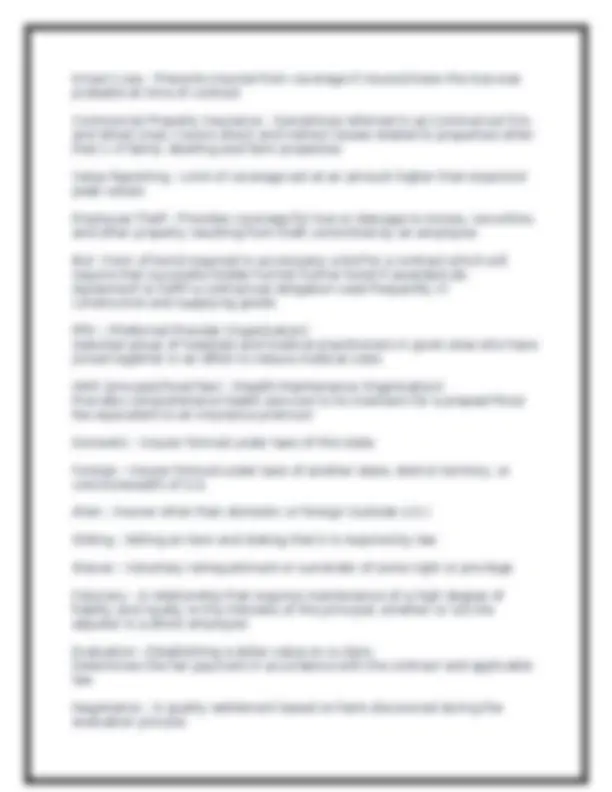
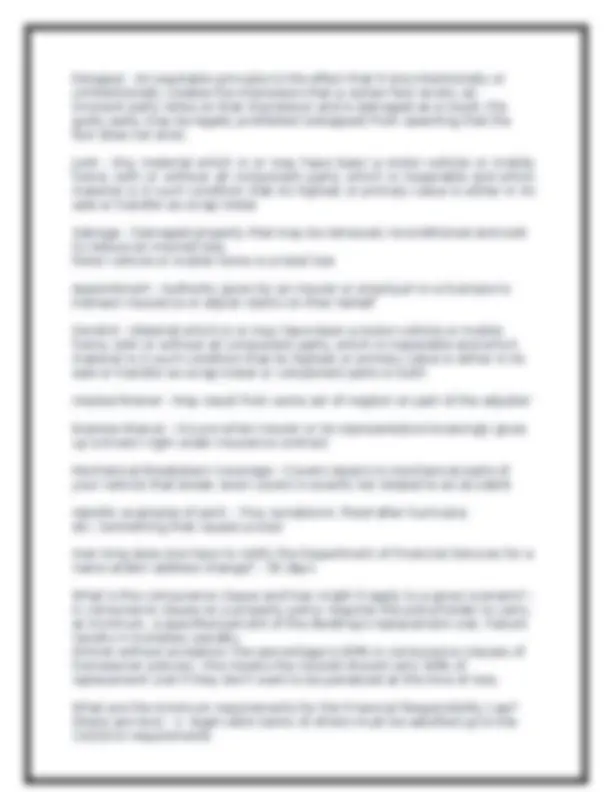
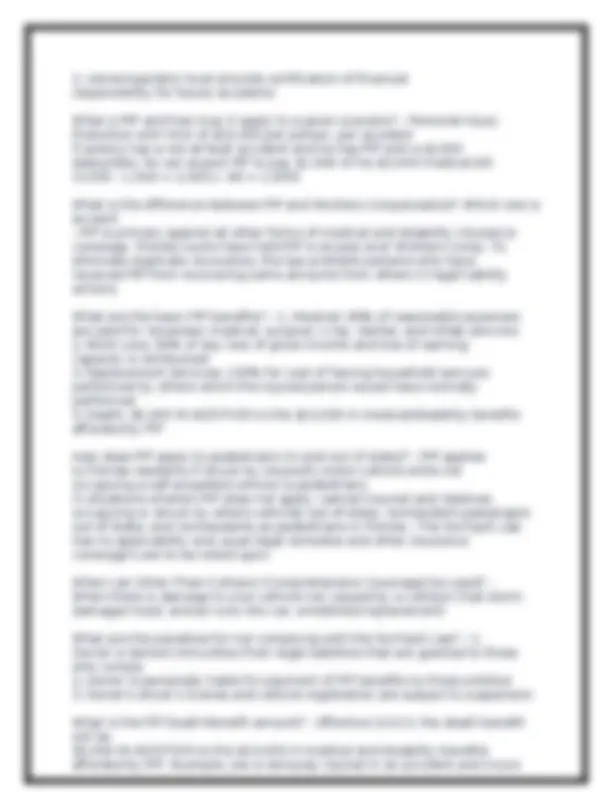
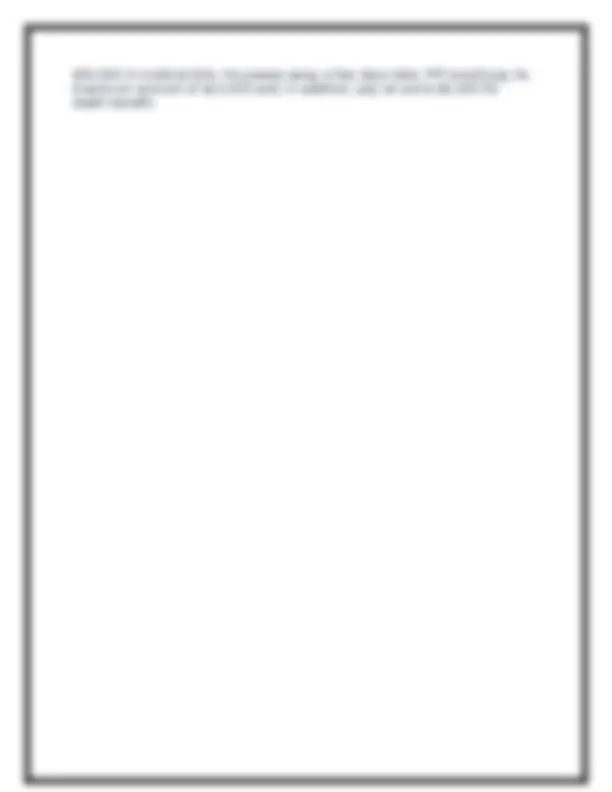
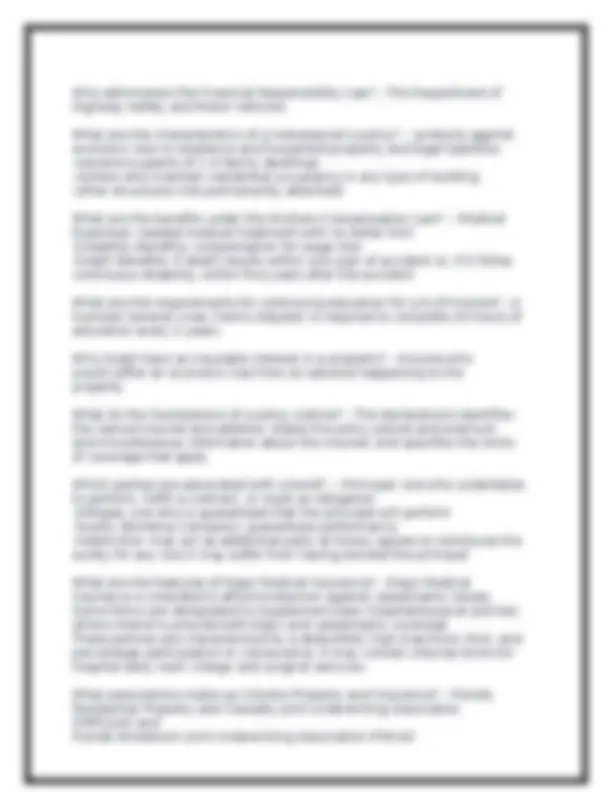
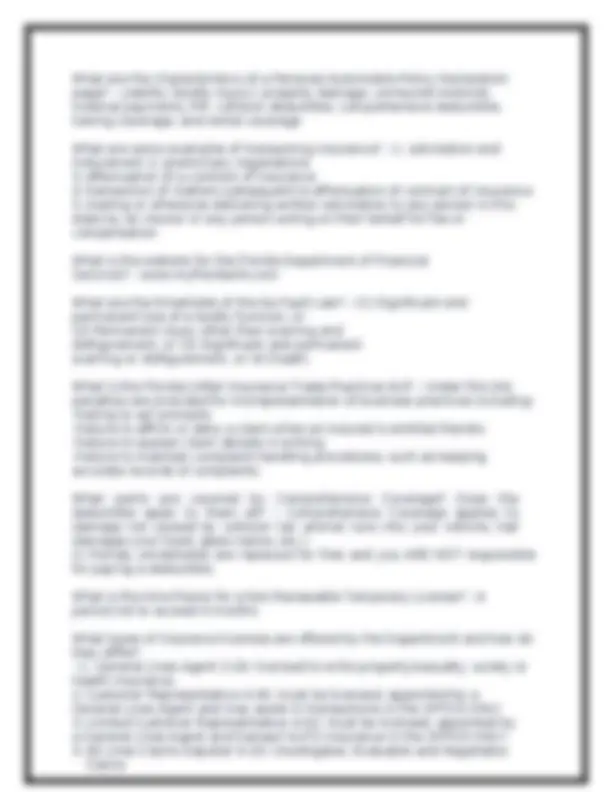

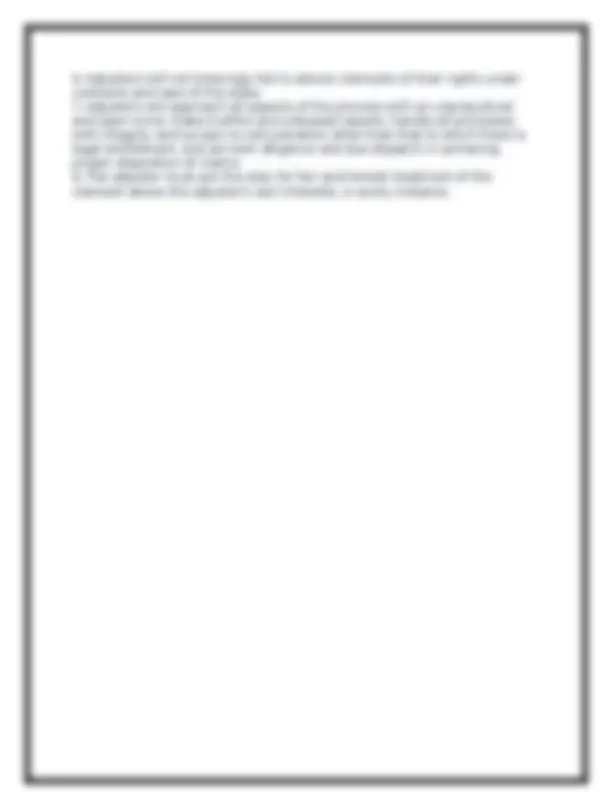


Study with the several resources on Docsity

Earn points by helping other students or get them with a premium plan


Prepare for your exams
Study with the several resources on Docsity

Earn points to download
Earn points by helping other students or get them with a premium plan
Community
Ask the community for help and clear up your study doubts
Discover the best universities in your country according to Docsity users
Free resources
Download our free guides on studying techniques, anxiety management strategies, and thesis advice from Docsity tutors
An in-depth analysis of various aspects of insurance policies and claims, including severability, abandonment, insurable interest, loss settlement valuation, warranties, and the roles and responsibilities of adjusters. It also covers topics such as mechanical breakdown coverage, no-fault law thresholds, business automobile policy coverage, workers compensation, and ethical considerations in claims handling.
Typology: Exams
1 / 51

This page cannot be seen from the preview
Don't miss anything!












































Frank owned a home that was destroyed by a hurricane. Both ABC and XYZ Banks were listed as additional interests on his homeowner policy. The insurance company will make a payment to: A. The first mortgagee, ABC B. The Insured C. Jointly to ABC and XYZ D. All listed interests - D. All listed interests Remember that the insurer is not responsible to know the degrees of interest. In the event of a loss, one payment is made by the insurer and it is up to the additional interests on working out their share. Insurance applies separately to each insured as if other insureds did not exist. This is defined as: A. Severability B. Conditional C. Warranty D. None of the above - A. Severability Property insurance policies usually contain a(n) clause, stating the insured cannot dump damaged property on the insurer and demand its full value: A. Pro Rata B. Abandonme nt C. Liberalization D. All of the above - B. Abandonment A(n) is one wherein economic loss would be suffered from an adverse happening to the subject: A. Conditional Contract B. Personal Contract C. Economic Contract D. Insurable Interest - D. Insurable Interest States that if the insurer adopts a revision which would broaden coverage without additional premium within some period of time prior to the policy period or during the policy period, the insured receives the benefit of such broadened coverage.
A. Cancellation Clause B. Policy Period
Contract D. All of the Above - A. Conditional Contract "may be conditioned" Which of the following is not one of the "Thresholds" in the "No-Fault" law?
A. Death of the Insured B. Temporary Injury of the Insured C. A permanent loss of a bodily function D. Permanent scarring on the face of the insured - B. Temporary Injury of the Insured Also included: permanent injury other than scarring and disfigurement Under Mechanical Breakdown Coverage, new cars are eligible for service up to: A. 36 Months/36,000 Miles B. 24 Months/36,000 Miles C. 12,000 Months/12,000 Miles D. 12 Months/36,000 Miles - A. 36 Months/36,000 Miles Used vehicles: 12 Months/12,000 Miles If financial responsibility doesn't exist at the time of an accident, which of the following things must happen to avoid penalties? A. The legally valid claims of others must be satisfied (up to 10/20/10) B. The owner and operator must provide certification of future responsibility for future accidents C. Both A & B D. None of the Above - C. Both A & B As to required proof for future accidents by purchase of auto liability insurance, the insurer must make a filing (Form SR-22) certifying that coverage is in effect, and this certification must remain on file for years: A. 1 B. 3 C. 4 D. 2 - B. 3 The Business Automobile Policy includes all of the following coverage forms except: A. The Garage Coverage Form B. The Trailer Interchange Coverage Form C. The Truckers Coverage Form D. The Business Auto Coverage Form - B. The Trailer Interchange Coverage Form Personal Injury Protection, or PIP, has a per person, per accident limit. A. 10, B. 20, C. 1, D. Depends on the damaged property - A. 10, Used to insure businesses engaged in selling, servicing, repairing, parking or storing automobiles: A. Servicing Coverage Form B. Garage Coverage Form C.
D. None of the Above - B. Garage Coverage Form The following examples are referred to as liability limits: 25/50/25 or 10/20/10. A. Split B. Single C. Straight D. None of the Above - A. Split 10/20/10 = 10,000 per person injured 20,000 all injuries combined 10,000 property damage Example of straight liability limit = $30, Jeremy has a not at fault accident. If he has PIP with a $1,000 deductible, how much can he expect his PIP coverage to pay toward his medical bills that total $3,000? A. $1, B. $1, C. $2, D. $3,000 - A. $1, 3000 (bills) - 1000 (deductible) = 2000 x .80 (eighty percent) Frank has a not-at-fault accident, he has basic PIP, no deductible and Med pay of $5,000. How much will his Med Pay contribute to medical bills of $15,000? A. $15, B. $5, C. $3, D. $0, Frank is not-at-fault - B. $5, Medical Payment limits apply per person; Frank will receive full amount towards medical bills. Which of the following is not one of the rating factors for a Homeowner's Policy? A. Type of Construction B. Location of Risk C. Age & Gender of Insured D. Proximity to Fire Department - C. Age & Gender of Insured On a Homeowner's Policy, covers items that are not permanently attached to the dwelling. This is defined as:
A. Other Structures B. Excess Structures C. Personal Property D. Dwelling - A. Other Structures Examples include sheds, fences, pool houses, detached car ports, etc.
Jeremy owns a home that is recently damaged due to a hurricane. The repair estimate is averaged at $25,000 and Jeremy decides to stay in a hotel because most of the damage is to his bedroom and kitchen. Under a Homeowner's Policy, what coverage will pay for the hotel room bill? A. Fair Rental Value B. Value Obligation C. Loss of Use D. Insurers Duties - C. Loss of Use The insurer will pay any necessary and reasonable expenses associated with a daily living routine. An insured who wishes to purchase flood insurance, but is located in a moderate or low risk flood zone may do so by purchasing a: A. Preferred Risk Flood Policy B. Standard Flood Policy C. Universal Flood Insurance D. None of the Above - A. Preferred Risk Flood Policy Although Flood Insurance is provided by the Federal Government, those who are not in a "flood zone" may purchase a preferred risk policy to cover them for a flood claim. Used only for Commercial Condominiums, it covers the unit-owners business personal property and the personal property of others in the insured's care, custody or control: A. Condominium Dwelling Form B. Personal Condominium Unit Owners Form C. Condominium Unit Owners Form D. None of the Above - C. Condominium Unit Owners Form Does not cover buildings since coverage would typically be provided under the Condo Association coverage form issued. The Commercial Property Contract includes all of the following, except: A. Common Policy Conditions B. Commercial Property Conditions C. Coverage Form D. Commercial Loss Schedule - D. Commercial Loss Schedule Also included: Declarations, Causes of Loss Form, Endorsements Insures a condominium association against direct physical loss or damage to buildings, business personal property and personal property of others in the care, custody or control of the association and located at the premises: A. Condominium Association Form B. Condominium Unit Owners Form C. Condominium Insured Owner Form D. None of the Above - A. Condominium Association Form This, along with Condo Unit Owners Form, is located under Condo Coverage.
Sometimes referred to as commercial fire and allied lines, this is the form of insurance that covers direct and indirect losses related to properties other than one-to-four family dwellings and farm properties: A. Business Property Insurance B. Building Property Insurance C. Commercial Property Insurance D. None of the Above - C. Commercial Property Insurance (the question is the definition for this term) Under Commercial Property Policies, Florida law requires an insurer to give the insured at least days advance written notice of non-renewal. A. 25 B. 90 C. 45 D. None of the Above - C. 45 Also, notice must state reasons the policy is not to be renewed. When a business's personal property values fluctuate, a single, fixed amount of insurance could produce either over- or under-insurance at any given time. With this option, the limit of coverage is set at an amount somewhat higher than expected peak values. A. Value Reporting B. Replacement Cost C. Agreed Value D. None of the Above - A. Value Reporting Replacement Cost is incorrect b/c it calculates monetary value of one's personal property Liberalization states, "The insured gets the benefit of any broadened coverage if the company, within days of inception, adopts a form revision that is broader and without increase in premium." A. 10 days B. 55 days C. 65 days D. 45 days - D. 45 days Used to cover buildings in the course of construction: A. Builders Risk Policy B. Builders Replacement Policy C. Construction Replacement Policy D. None of the Above - A. Builders Risk Policy Includes: structure being built (including foundations), fixtures and machinery, equipment to service building, owned materials and supplies used for construction. Temporary structures built or assembled on site are also included if not covered by insurance.
Also included: Nuclear Energy Liability Exclusion endorsement (other endorsements may be attached) There is coverage for injury, damage or clean-up costs caused by pollutants, subject to minor exceptions: A. 50% B. 10% C. 0% D. A Percentage Ratio - C. 0% Under a Commercial General Liability Policy, a basic limit of per person applies to Medical Payments: A. $1, B. $10, C. $2, D. $5,000 - D. $5, Payment is for medical, dental, hospital, and funeral services incurred within one year of date of accident to persons who suffer bodily injury by accident
neighboring community This is an example of? A. Loss Known B. Known Loss C. Claims- Made D. None of the Above - B. Known Loss
Mandatory for risks exceeding certain annual premiums, recognizes the prior loss experience of the risk and applies either a debit for unfavorable experience or a credit for better-than-expected loss results. This is defined as: A. The Experience Rating Plan B. The Retrospective Rating Plan C. The Risk Plan D. None of the Above - A. The Experience Rating Plan This, along with Retrospective Rating Plan, is a manual rating process until premiums reach a certain level. Under workers compensations, a rate is charged for every of payroll to employees. A. $ B. $1, C. $ D. $500 - A. $ The National Council on Compensation Insurance enforces this rating. Under Workers Compensation, Part Four Your Duties if Injuries Occur, an employer is required to: A. Provide the names/addresses of injured persons and witnesses B. Promptly provide any legal papers C. Cooperate and assist as insurer requests D. All of the Above - D. All of the Above Also included: immediate contact with insurer, providing immediate medical or other services, do nothing to interfere with insured's right of recovery, make no voluntary payments or assume any obligation except at employer's own cost. Under Workers Compensation, Employers Liability includes: A. Claims by others for the liabilities to insureds employees B. Claims by relatives of injured employees for consequential damages C. Claims made by employees that are not subject to Workers Comp Laws D. All of the Above - D. All of the Above Samantha eats uncooked chicken at a local barbecue joint and becomes violently ill. Which of the following workers compensation benefits would pay for this occurrence? A. A products and completed operations form B. A premises and operations form C. An owners and contractors protective liability form D. None of the Above - D. None of the Above Samantha is not an employee of the barbecue joint; Workers Comp does not apply. An optional alternative providing for adjustment of premium after expiration,
based on a guaranteed basic premium to the insurer to which is added the actual losses incurred by the insured. This is defined as: A. Cost-Plus Rating Plan
Sustained Loss D. None of the Above - B. Loss Sustained One exception to the rule is that Loss Sustained forms will also cover losses that occurred under previous (expired) crime policies and that were discovered during current policy year, as long as crime coverage had continued w/o interruption
Any loss discovered during the policy period or within 60 days after its expiration (one year after expiration for losses connected with employee benefit plans) is covered regardless of when it occurred. This is defined as: A. Loss Sustained B. Valuation C. Discovery D. None of the Above - C. Discovery If XYZ restaurant discovers stolen goods taken over a year ago, this is within 2 years of inception date and found within policy period so it's covered. Under Crime Insurance, the insured is covered for loss by: A. Theft B. Burglary C. Robbery D. All of the Above - D. All of the Above Unless the loss is specifically excluded or limited Provides for loss of money and securities outside the premises in the care, custody and control of a messenger or armored car service resulting from theft, disappearance or destruction. This is defined as: A. Inside the Premises B. Outside the Premises C. Care, Custody, & Control D. None of the Above - B. Outside the Premises Also covers robbery of other property under the circumstances. Taking or attempted taking of property from within a locked safe or vault, by unlawful entry, with visible marks of forcible entry, or taking of the safe or vault from inside the premises. This is defined as: A. Safe Burglary B. Inside the Premises C. Custodial Burglary D. None of the Above - A. Safe Burglary Exclusions: accounting errors, giving/surrendering property, voluntarily parting, fire (except damage to safe/vault), vandalism, transferring property to someone based on unauthorized instructions or from threat to harm Covers for all types of property, when surrendered away from the premises as a result of a threat to do bodily harm to the insured or an employee, or to a relative or invitee of either, who is (or allegedly is) being held captive. This is defined as: A. Extortion B. Surrendered Property C. Client's